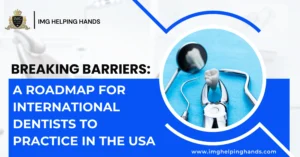
The Medical Residency Application Process 2025: How IMG Helping Hands Can Assist You
Have you ever wondered what it truly takes to secure your dream residency in an ever-evolving medical landscape? As we step into 2025, the residency

Getting quality clinical experience in the US is crucial for international medical students and graduates (IMGs) who want to match into a US residency program. Clinical experience, often referred to as rotations or electives, provides hands-on training in a medical setting that allows students to hone their clinical skills and demonstrate their abilities to residency programs.
With competition for residency spots at an all-time high, clinical experience in the US can give IMGs a vital edge. It offers exposure to the US healthcare system, shows commitment to training in the US, and helps students gain strong letters of recommendation (LoRs) for their residency applications.
Additionally, it provides opportunities to make professional connections and become familiar with the culture of US residency programs. Let’s look closer at the value of US clinical experience and how private practice can fulfill the clinical requirements for IMG students and graduates.
Before exploring options, it’s important to understand what constitutes quality clinical experience. According to the Association of American Medical Colleges (AAMC), clinical experience involves direct patient interactions and training in a hands-on clinical setting under physician supervision. Students are able to apply their medical knowledge, develop clinical skills, and gain exposure to healthcare delivery systems.
Clinical experience is a vital component of medical education. Here are some of the key benefits:
Without quality clinical training, medical students lack opportunities to transform their medical knowledge into real-world clinical skills.
For IMGs, clinical experience specifically in the US offers additional advantages:
There are a few main ways for international students to obtain clinical experience in the US:
Statistics clearly show the benefits of US clinical experience for matching into a residency program:
Overall, IMGs simply cannot afford to overlook the value of hands-on US clinical experience in their medical education. It can make or break residency placement.
Many students arrange US clinical experience in private practice settings. But what exactly is private practice and how does it help fulfill training requirements?
Private practice refers to a physician or group of physicians operating an independent healthcare business outside of hospital systems or academic medical centers. Private practices include doctors’ offices, outpatient clinics, and ambulatory care centers for specialties like family medicine, pediatrics, internal medicine, and more.
Here are some of the key advantages of private practice for clinical experience:
Securing private practice clinical experience takes proactivity but is very rewarding. Here are some tips:
With persistence and preparation, private practice rotations can greatly strengthen your US clinical experience portfolio.
Two common programs offered through private practices are observerships and shadowing. Here’s an overview of how these programs work:
Observerships allow students to closely observe physicians in a clinical setting. Responsibilities may include:
Observerships last anywhere from a few weeks up to a year, often focusing on a particular specialty.
Shadowing also lets students closely follow physicians through their day-to-day work. Key activities include:
Shadowing arrangements are typically more informal and short-term than observerships.
Here are some of the benefits observerships and shadowing provide:
While less hands-on than rotations, shadowing is valuable for reinforcing clinical knowledge. Both opportunities help students gain experience and contacts.
IMGs often face obstacles in obtaining US clinical experience and securing a residency spot. However, with planning and resourcefulness, these challenges can be overcome.
Some key hurdles IMGs encounter include:
However, IMGs can take steps to proactively address these challenges:
Besides private practice, here are some other ways IMGs can gain vital US clinical exposure:
Observership programs – Structured observership and externship programs through ECFMG
Academic medical centers – Reach out to departments at large US hospitals and teaching facilities
Scribe training – Paid programs focused on building charting and documentation skills
Simulation training – Use simulation labs and standardized patient programs to hone clinical competencies
Virtual rotations – Complete online rotations focused on US healthcare delivery and concepts
Research – Assist on clinical research studies and trials to demonstrate skills and initiative
Cast a wide net and get creative. Building a robust portfolio of US training experience is key.
The COVID-19 pandemic severely disrupted medical training and residency placement:
However, virtual solutions helped mitigate challenges:
The pandemic presents obstacles but also opportunities to leverage technology and demonstrate resilience. Programs understand COVID’s impacts and are adapting evaluation approaches. With strategic planning, strong applications, and persistence, IMG students can still obtain clinical training, create connections, and match into great programs. The keys are flexibility and determination.
Observerships, shadowing programs, and private practice rotations provide excellent clinical training opportunities in the US. However, here are two other options IMGs can consider to get clinical exposure and strengthen their residency applications:
Medical scribe programs allow pre-med students and graduates to work alongside physicians, documenting patient encounters in real time. Scribes gain clinical experience by:
Scribe programs offer fixed curriculums focused on clinical knowledge and tech skills. Some programs hire and train international students to work for 6-12 months. This gives IMGs exposure to US healthcare delivery models while earning an income.
When US clinical experience isn’t feasible, students can still benefit from shadowing physicians in their home country or regions like Europe or Australia. This helps build:
Shadowing abroad is not a replacement for USCE, but it demonstrates clinical initiative. Students can highlight their global experiences in their residency applications.
Gaining quality clinical experience in the US provides invaluable preparation for IMGs hoping to match into a US residency program. While competitive, positions are attainable through creative planning, outreach, and utilizing avenues like private practice rotations, observerships, and scribe training. This hands-on exposure allows students to hone competencies, gain insights into American healthcare training and delivery, and build their professional network – all of which strengthen residency candidacy. With determination and resilience, IMGs can get the US clinical training needed to achieve their medical career goals.
Get our most valuable tips right inside your inbox, once per month!

Have you ever wondered what it truly takes to secure your dream residency in an ever-evolving medical landscape? As we step into 2025, the residency

For IMGs, to practice medicine in USA is more than just passing USMLE and securing a residency; it also involves surfing through the intimidating visa

Are you ready to embark on one of the most transformative journeys in your medical career? The residency match process is a pivotal step for

Pursuing medical research in the United States offers unparalleled opportunities for academic growth, access to cutting-edge technology, and the ability to work alongside leading experts

Embarking on a journey to practice dentistry in the United States is a dream for many international dentists. In the vast landscape of American dentistry,

Have you ever considered the transformative power of aesthetics in the field of medicine? Is aesthetic medicine the silent cornerstone of modern clinical practice? Within
We are here to provide a safe and secure helping hand for medical students, graduates, and residents.
Our comprehensive guide will assist you in matching with your top-choice residency or fellowship program.




Payment Methods
Buy with Confidence
© IMG Helping Hands Copyrights 2024 Developed By Ecom Thrust